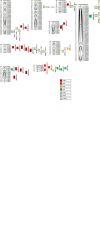Identification of Stable and Multiple Environment Interaction QTLs and Candidate Genes for Fiber Productive Traits Under Irrigated and Water Stress Conditions Using Intraspecific RILs of Gossypium hirsutum var. MCU5 X TCH1218
- PMID: 35519814
- PMCID: PMC9062235
- DOI: 10.3389/fpls.2022.851504
Identification of Stable and Multiple Environment Interaction QTLs and Candidate Genes for Fiber Productive Traits Under Irrigated and Water Stress Conditions Using Intraspecific RILs of Gossypium hirsutum var. MCU5 X TCH1218
Abstract
Cotton productivity under water-stressed conditions is controlled by multiple quantitative trait loci (QTL). Enhancement of these productivity traits under water deficit stress is crucial for the genetic improvement of upland cotton, Gossypium hirsutum. In the present study, we constructed a genetic map with 504 single nucleotide polymorphisms (SNPs) covering a total span length of 4,416 cM with an average inter-marker distance of 8.76 cM. A total of 181 intra-specific recombinant inbred lines (RILs) were derived from a cross between G. hirsutum var. MCU5 and TCH1218 were used. Although 2,457 polymorphic SNPs were detected between the parents using the CottonSNP50K assay, only 504 SNPs were found to be useful for the construction of the genetic map. In the SNP genotyping, a large number of SNPs showed either >20% missing data, duplication, or segregation distortion. However, the mapped SNPs of this study showed collinearity with the physical map of the reference genome (G. hirsutum var.TM-1), indicating that there was no chromosomal rearrangement within the studied mapping population. RILs were evaluated under multi-environments and seasons for which the phenotypic data were acquired. A total of 53 QTL controlling plant height (PH), number of sympodial branches, boll number (BN), and boll weight (BW) were dissected by QTL analysis under irrigated and water stress conditions. Additionally, it was found that nine QTL hot spots not only co-localized for more than one investigated trait but were also stable with major QTL, i.e., with > 10% of phenotypic variation. One QTL hotspot on chromosome 22 flanked by AX-182254626-AX-182264770 with a span length of 89.4 cM co-localized with seven major and stable QTL linked to a number of sympodial branches both under irrigated and water stress conditions. In addition, putative candidate genes associated with water stress in the QTL hotspots were identified. Besides, few QTL from the hotspots were previously reported across various genetic architects in cotton validating the potential applications of these identified QTL for cotton breeding and improvement. Thus, the major and stable QTL identified in the present study would improve the cotton productivity under water-limited environments through marker-assisted selection.
Keywords: QTL; SNP; drought; genetic map; intra-specific cross; productive traits; upland cotton.
Copyright © 2022 Boopathi, Tiwari, Jena, Nandhini, Sri Subalakhshmi, Shyamala, Joshi, Premalatha and Rajeswari.
Conflict of interest statement
The authors declare that the research was conducted in the absence of any commercial or financial relationships that could be construed as a potential conflict of interest.
Figures


Similar articles
-
High-density linkage map construction and QTL analyses for fiber quality, yield and morphological traits using CottonSNP63K array in upland cotton (Gossypium hirsutum L.).BMC Genomics. 2019 Nov 21;20(1):889. doi: 10.1186/s12864-019-6214-z. BMC Genomics. 2019. PMID: 31771502 Free PMC article.
-
Enhancing Upland cotton for drought resilience, productivity, and fiber quality: comparative evaluation and genetic dissection.Mol Genet Genomics. 2020 Jan;295(1):155-176. doi: 10.1007/s00438-019-01611-6. Epub 2019 Oct 16. Mol Genet Genomics. 2020. PMID: 31620883
-
Identification of stable quantitative trait loci (QTLs) for fiber quality traits across multiple environments in Gossypium hirsutum recombinant inbred line population.BMC Genomics. 2016 Mar 8;17:197. doi: 10.1186/s12864-016-2560-2. BMC Genomics. 2016. PMID: 26951621 Free PMC article.
-
Fiber Quality Improvement in Upland Cotton (Gossypium hirsutum L.): Quantitative Trait Loci Mapping and Marker Assisted Selection Application.Front Plant Sci. 2019 Dec 11;10:1585. doi: 10.3389/fpls.2019.01585. eCollection 2019. Front Plant Sci. 2019. PMID: 31921240 Free PMC article. Review.
-
Genetic Diversity, QTL Mapping, and Marker-Assisted Selection Technology in Cotton (Gossypium spp.).Front Plant Sci. 2021 Dec 16;12:779386. doi: 10.3389/fpls.2021.779386. eCollection 2021. Front Plant Sci. 2021. PMID: 34975965 Free PMC article. Review.
Cited by
-
Genetic architecture of key traits for Prunus crop improvement: an overview of 25 years of curated genomic and breeding data.Hortic Res. 2025 May 30;12(8):uhaf142. doi: 10.1093/hr/uhaf142. eCollection 2025 Aug. Hortic Res. 2025. PMID: 40698195 Free PMC article.
References
-
- Abdelraheem A., Fang D. D., Zhang J. (2018). Quantitative trait locus mapping of drought and salt tolerance in an introgressed recombinant inbred line population of upland cotton under the greenhouse and field conditions. Euphytica 214 1–20.
-
- Abdelraheem A., Thyssen G. N., Fang D. D., Jenkins J. N., McCarty J. C., Wedegaertner T., et al. (2021). GWAS reveals consistent QTL for drought and salt tolerance in a MAGIC population of 550 lines derived from intermating of 11 Upland cotton (Gossypium hirsutum) parents. Mol. Genet. Genomics 296 119–129. 10.1007/s00438-020-01733-2 - DOI - PubMed
-
- Bao Y., Zhao R., Li F., Tang W., Han L. (2011). Simultaneous expression of Spinacia oleracea chloroplast choline monooxygenase (CMO) and betaine aldehyde dehydrogenase (BADH) genes contribute to dwarfism in transgenic Lolium perenne. Plant Mol. Biol. Rep. 29 379–388. 10.1007/s11105-010-0243-8 - DOI
-
- Boopathi N. M. (2020). Genetic Mapping and Marker Assisted Selection: Basics, Practice and Benefits, 2nd Edn. Singapore: Springer.
-
- Boopathi N. M., Hoffmann L. V. (2016). “Genetic diversity, erosion, and population structure in cotton genetic resources,” in Genetic Diversity and Erosion in Plants. Sustainable Development and Biodiversity, eds Ahuja M., Jain S. (Cham: Springer; ), 409–438. 10.1007/978-3-319-25954-3_12 - DOI
LinkOut - more resources
Full Text Sources

